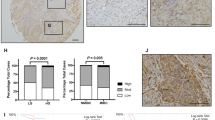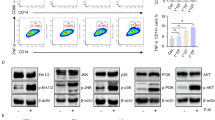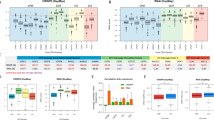Abstract
Plasminogen activator inhibitor 1 (PAI-1) has been found to be a bad prognostic factor in a number of tumours but the reason has not been fully explained. The human prostate cancer cell line PC-3 and the human promyelocytic leukaemia cell line HL-60 were used in this study to determine the effect of PAI-1 on spontaneous and induced apoptosis in culture. Apoptosis was induced with camptothecin or etoposide. Addition of a stable variant of PAI-1 or wild-type PAI-1 to these cells resulted in a significant inhibition of apoptosis. In contrast, both the latent form of PAI-1 and the stable variant of PAI-1 inactivated by a specific neutralizing monoclonal antibody, or the stable variant of PAI-1 in a complex with recombinant urokinase did not inhibit apoptosis. This indicated that the inhibitory activity of PAI-1 was required for its anti-apoptotic effect but the urokinase-type plasminogen activator receptor was not involved. These findings provide an explanation for the bad prognostic correlation of high PAI-1 levels in tumours. The anti-apoptotic effect was also found in non-tumoural cells including human umbilical vein endothelial cells and the benign human breast epithelial cell line MCF-10A, suggesting that this is a novel physiologic function of PAI-1. © 2000 Cancer Research Campaign
Similar content being viewed by others
Article PDF
Change history
16 November 2011
This paper was modified 12 months after initial publication to switch to Creative Commons licence terms, as noted at publication
References
Alizadeh H, Ma D, Berman M, Bellingham D, Comerford SA, Gething MH, Sambrook JF and Niederkorn JY (1995) Tissue-type plasminogen activator-induced invasion and metastasis of murine melanomas. Curr Eye Res 14: 449–458
Andreasen PA, Kjoller L, Christensen L and Duffy MJ (1997) The urokinase-type plasminogen activator system in cancer metastasis: a review. Int J Cancer 72: 1–22
Bajou K, Noel A, Gerard RD, Masson V, Brunner N, Holst-Hansen C, Skobe M, Fusening NE, Carmeliet P, Collen D and Foidart JM (1998) Absence of host plasminogen activator inhibitor 1 prevents cancer invasion and vascularization. Nat Med 4: 923–928
Bashar H, Urano T, Pietrazek MH, Hata M, Suzuki K, Kawabe K, Takada Y and Takada A (1994) Plasminogen activators and plasminogen activator inhibitor 1 in urinary tract cancer. Urol Int 52: 4–8
Cajot JF, Bamat J, Bergonzelli GE, Kruithof EKO, Medcalf RL and Testuz J (1990) Plasminogen activator inhibitor type 1 is a potent natural inhibitor of extracellular matrix degradation by fibrosarcoma and colon carcinoma cells. Proc Natl Acad Sci USA 87: 6939–6943
Casslen B, Bossmar T, Lecander I and Astedt B (1994) Plasminogen activators and plasminogen activator inhibitors in blood and tumor fluids of patients with ovarian cancer. Eur J Cancer 30: 1302–1309
Dano K, Andreasen PA, Grondahl-Hansen J, Kristensen P, Nielsen LS and Skriver L (1985) Plasminogen activators, tissue degradation, and cancer. Adv Cancer Res 44: 139–266
Debrock S and Declerck PJ (1997) Neutralization of plasminogen activator inhibitor-1 inhibitory properties: identification of two different mechanisms. Biochim Biophys Acta 1337: 257–266
Deng G, Curriden SA, Wang S, Rosenberg S and Loskutoff DJ (1996) Is plasminogen activator inhibitor-1 the molecular switch that governs urokinase receptor-mediated cell adhesion and release?. J Cell Biol 134: 1563–1571
Egelund R, Schousboe SL, Sottrup-Jensen L, Rodenburg KW and Andreasen PA (1997) Type-1 plasminogen-activator inhibitor: conformational differences between latent, active, reactive-centre-cleaved and plasminogen-activator-complexed forms, as probed by proteolytic susceptibility. Eur J Biochem 248: 775–785
Foekens JA, Schmitt M, van Putten WL, Peters HA, Kramer MD, Janicke F and Klijn JG (1993) Plasminogen activator inhibitor-1 and prognosis in primary breast cancer. J Clin Oncol 12: 1648–1658
Gils A, Knockaert I and Declerck PJ (1996) Substrate behavior of plasminogen activator inhibitor-1 is not associated with a lack of insertion of the reactive site loop. Biochem 35: 7474–7481
Grondahl-Hansen J, Christensen IJ, Rosenquist C, Brunner N, Mouridsen HT, Dano K and Blichert-Toft M (1993) High levels of urokinase-type plasminogen activator and its inhibitor PAI-1 in cytosolic extracts of breast carcinomas are associated with poor prognosis. Cancer Res 53: 2513–2521
Hofmann R, Lehmer A, Buresch M, Hartung R and Ulm K (1996) Clinical relevance of urokinase plasminogen activator, its receptor, and its inhibitor in patients with renal cell carcinoma. Cancer 78: 487–492
Janicke F, Schmitt M, Pache L, Ulm K, Harbeck N, Hofler H and Graeff H (1993) Urokinase (uPA) and its inhibitor PAI-1 are strong and independent prognostic factors in node-negative breast cancer. Breast Cancer Res Treat 24: 195–208
Kanse SM, Kost C, Wilhelm OG, Andreasen PA and Preissner KT (1996) The urokinase receptor is a major vitronectin binding protein on endothelial cells. Exp Cell Res 224: 344–353
Kjoller L, Kanse SM, Kirkegaard T, Rodenburg KW, Ronne E, Goodman SL, Preissner KT, Ossowski L and Andreasen PA (1997) Plasminogen activator inhibitor-1 represses integrin- and vitronectin-mediated cell migration independently of its function as an inhibitor of plasminogen activation. Exp Cell Res 232: 420–429
Kobayashi H, Fujishiro S and Terao T (1994) Impact of urokinase-type plasminogen activator and its inhibitor type 1 on prognosis in cervical cancer of the uterus. Cancer Res 54: 6539–6548
Kuhn W, Pache L, Schmalfeldt B, Dettmar P, Schmitt M, Janicke F and Graeff H (1994) Urokinase (uPA) and PAI-1 predict survival in advanced ovarian cancer patients (FIGO III) after radical surgery and platinum-based chemotherapy. Gynecol Oncol 55: 401–409
Kwaan HC (1992) The plasminogen-plasmin system in malignancy. Cancer Metast Rev 11: 291–311
Levenson AS, Kwaan HC, Svoboda KM, Weiss IM, Sakurai S and Jordan VC (1998) Oestradiol regulation of the components of the plasminogen-plasmin system in MDA-MB-231 human breast cancer cells stably expressing the oestrogen receptor. Br J Cancer 78: 88–95
Nekarda H, Siewert JR, Schmitt M and Ulm K (1994) Tumour-associated proteolytic factors uPA and PAI-1 and survival in totally resected gastric cancer. Lancet 343: 117
Pedersen H, Grondahl-Hansen J, Francis D, Osterlind K, Hansen HH, Dano K and Brunner N (1994) Urokinase and plasminogen activator inhibitor type 1 in pulmonary adenocarcinoma. Cancer Res 54: 120–123
Sancho E, Declerck PJ, Price NC, Kelly SM and Booth NA (1995) Conformational studies on plasminogen activator inhibitor (PAI-1) in active, latent, substrate, and cleaved forms. Biochemistry 34: 1064–1069
Sier CFM, Vloedgraven HJM, Ganesh S, Griffion G, Quax PHA, Verheijen JH, Dooijewaard G, Welvaart K, van de Velde CJH, Lamers CBHW and Verspaget H (1994) Inactive urokinase and increased levels of inhibitor type 1 in colorectal cancer liver metastasis. Gastroenterology 10: 1449–1456
Soff GA, Sanderowitz J, Gately S, Verrusio E, Weiss I, Brem S and Kwaan HC (1995) Expression of plasminogen activator inhibitor type 1 by human prostate carcinoma cells inhibits primary tumor growth, tumor-associated angiogenesis, and metastasis to lung and liver in an athymic mouse model. J Clin Invest 96: 2593–2600
Stefansson S and Lawrence DA (1996) The serpin PAI-1 inhibits cell migration by blocking integrin alpha V beta 3 binding to vitronectin. Nature 383: 441–443
Sugiura Y, Ma L, Sun B, Shimada H, Laug WE, Seeger RC and DeClerck Y (1999) The plasminogen-plasminogen activator (PA) system in neuroblastoma: role of PA inhibitor-1 in metastasis. Cancer Res 59: 1327–1336
Verhamme I, Kvassman J, Day D, Debrock S, Vleufels N, Declerck PJ and Shore JD (1999) Accelerated conversion of human plasminogen activator inhibitor-1 to its latent form by antibody binding. J Biol Chem 274: 17511–17517
Vleugels N, Gils A, Mannaerts S, Knockaert I and Declerck PJ (1998) Evaluation of the mechanism of inactivation of plasminogen activator-1 by monoclonal antibodies using a stable variant. Fibrinolysis Proteolysis 12: 277–282
Waltz DA, Natkin LR, Fujita RM, Wei Y and Chapman HA (1997) Plasmin and plasminogen activator inhibitor type 1 promote cellular motility by regulating the interaction between the urokinase receptor and vitronectin. J Clin Invest 100: 58–67
Wei Y, Waltz DA, Rao N, Drummond RJ, Rosenberg S and Chapman HA (1994) Identification of the urokinase receptor as an adhesion receptor for vitronectin. J Biol Chem 269: 32380–32388
Author information
Authors and Affiliations
Rights and permissions
From twelve months after its original publication, this work is licensed under the Creative Commons Attribution-NonCommercial-Share Alike 3.0 Unported License. To view a copy of this license, visit http://creativecommons.org/licenses/by-nc-sa/3.0/
About this article
Cite this article
Kwaan, H., Wang, J., Svoboda, K. et al. Plasminogen activator inhibitor 1 may promote tumour growth through inhibition of apoptosis. Br J Cancer 82, 1702–1708 (2000). https://doi.org/10.1054/bjoc.2000.1207
Received:
Revised:
Accepted:
Published:
Issue date:
DOI: https://doi.org/10.1054/bjoc.2000.1207
Keywords
This article is cited by
-
PAI-1 is a potential transcriptional silencer that supports bladder cancer cell activity
Scientific Reports (2022)
-
Spontaneous regression of micro-metastases following primary tumor excision: a critical role for primary tumor secretome
BMC Biology (2020)
-
miR-34a exerts as a key regulator in the dedifferentiation of osteosarcoma via PAI-1–Sox2 axis
Cell Death & Disease (2018)
-
The influence of platelet membranes on tumour cell behaviour
Cancer and Metastasis Reviews (2017)
-
uPA and PAI-1 as biomarkers in breast cancer: validated for clinical use in level-of-evidence-1 studies
Breast Cancer Research (2014)



